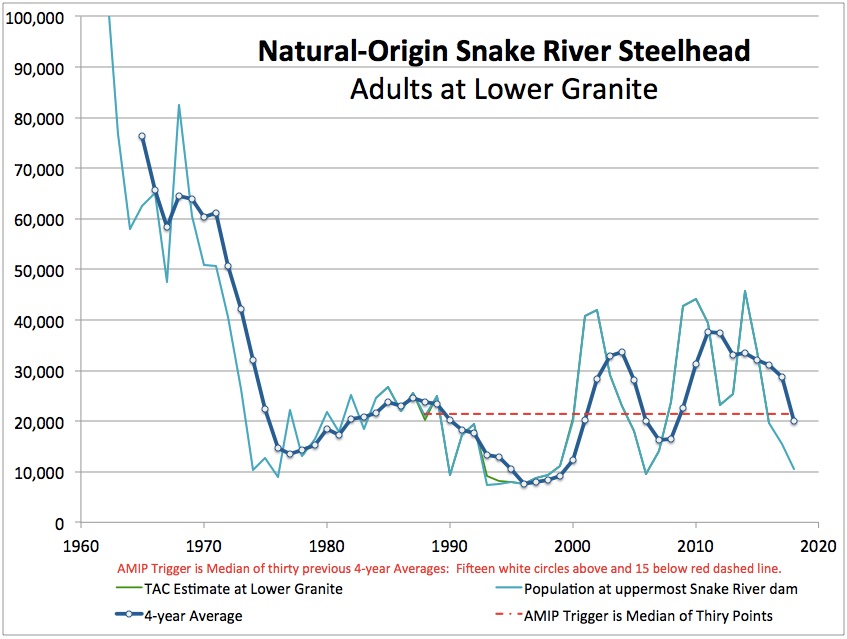forum
library
tutorial
contact

Refutes Dugger
by Don ChapmanLewiston Tribune, September 9, 2021
|
the film forum library tutorial contact |

|
Refutes Duggerby Don ChapmanLewiston Tribune, September 9, 2021 |
Dugger did not choose to discuss the effects of barge transportation on straying of returning adults.
 Marvin Dugger, an advocate for barge transport of salmon and steelhead, produced a commentary supporting barging as the answer for fish management. ...
Marvin Dugger, an advocate for barge transport of salmon and steelhead, produced a commentary supporting barging as the answer for fish management. ...
He asked: "Where did the early harvest rates of 64 percent for salmon and 54 percent for steelhead below Bonneville Dam go?" They are the addition of all catches inventoried annually in zones 1-5 downstream from Bonneville Dam by Oregon and Washington fish agencies in 1938-1993, plus annual fish passage at Bonneville Dam. The resulting statistic was termed "minimum run. ..."
"Harvest rate" results from annual catch divided by minimum run.
Dugger concluded smolt-to-adult comparisons between the John Day, Yakima, and Snake rivers are "unfair" because SAR declines as fish migrate farther upstream. ...
Peer-reviewed and published reports found salmon smolt survival between White Bird smolt trap and Ice Harbor Dam (before Lower Monumental, Little Goose and Lower Granite dams were in place) equaled 89 percent. Present survivals over the same reach now average about 60 percent.
Dugger did not choose to discuss the effects of barge transportation on straying of returning adults. If one cares about wild salmon and steelhead, such straying is important. It reduces adaptation for two-dozen or more wild fish genetic groupings of spring chinook and two dozen such groups in steelhead in Idaho and Oregon spawning areas. ...
When the transportation program seemed to have promise in the 1980s, I supported it. Transportation lost its luster for me when careful peer-reviewed studies showed negative effects of hatchery fish spawning with wild adults. ...
Related Pages:
Army Corps Does Not Agree by Keith Carlson, Lewiston Tribune, 9/9/21
Agrees with Dugger, Bentz by Steven Erson, Lewiston Tribune, 9/2/21
Breach the Lower Snake River Dams and We Will Lose Our Fish by Marvin F. Dugger, Lewiston Tribune, 8/1/21
Sound Science and Experience Refute Dugger's Fish Story by Steve Pettit & Richard Scully, Lewiston Tribune, 8/14/21
Saving Salmon is a Ruse for Breaching Our Dams by Marvin F. Dugger, Lewiston Tribune, 3/14/21
What About the Dams? by Marvin F. Dugger, Lewiston Tribune, 11/3/19
Mr. Marvin Dugger, an advocate for barge transport of salmon and steelhead, produced a commentary supporting barging as the answer for fish management.I have a few points that bear upon Mr. Dugger's foray into historical fish numbers and science.
First, he states that two retired IDFG biologists (R Scully and S. Pettit) are wrong and do not make sense.
He asked "Where did the early harvest rates of 64% for salmon and 54% for steelhead below Bonneville Dam come from?" They are the addition of all catches inventoried annually in zones 1-5 downstream from Bonneville Dam by Oregon and Washington fish agencies in 1938-1993, plus annual fish passage at Bonneville Dam. The resulting statistic was termed "Minimum Run," and it can be found in Chapman et al. (1994) and other publications. "Harvest rate" results from annual catch divided by minimum run.
Mr. Dugger concluded that smolt-to-adult (SAR) comparisons between the John Day, Yakama, and Snake rivers are "unfair" because SAR declines as fish migrate farther upstream. I think he is disingenuous. He must have seen or heard that SARs for spring chinook salmon and steelhead returns to the Snake River were 2 to 6% before the four lower Snake River dams were completed.
Peer-reviewed and published reports (see Raymond 1979) found that salmon smolt survival between White Bird smolt trap and Ice Harbor Dam (before Lower Monumental, Little Goose, and Lower Granite dams were in place) equaled 89%. Present survivals over the same reach now average about 60%.
Mr. Dugger did not choose to discuss the effects of barge transportation on straying of returning adults. If one cares about wild salmon and steelhead, such straying is important because it reduces adaptation for the two-dozen or more wild fish genetic groupings of spring chinook and two dozen such groups in steelhead in Idaho and Oregon spawning areas. I consider such loss as very important as wild spawning declines.
When the transportation program seemed to have promise in the 1980s, I supported the effort. Transportation lost its luster for me when careful peer-reviewed studies showed negative effects of hatchery fish spawning with wild adults.
Mr. Dugger lumps hatchery and wild fish, seeming not to care that many wild genetic groups should be re-classified under ESA provisions as endangered, not as the present designation as "threatened."
Dugger "shares the Corps' view" of transportation. Mssrs. Pettit and Scully, and I, certainly do not.
learn more on topics covered in the film
see the video
read the script
learn the songs
discussion forum
